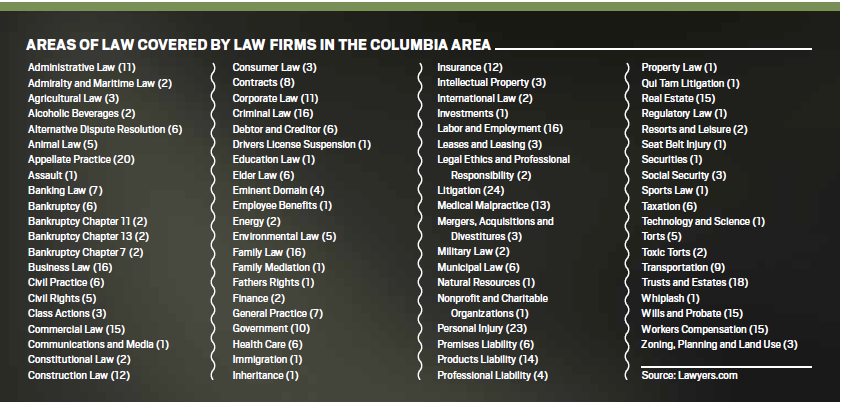Law and Order
In 2012, when Sherry Hunt, a False Claims Act Realtor, sued her employer Citigroup for systematically violating U.S. mortgage regulations, the $158.3 million settlement made national news. In the same respect, so did Rotts & Gibbs LLC, the Columbia law firm that represented Hunt. The firm also received financial compensation for their efforts, which, unlike the settlement amount, is confidential. But that doesn’t stop the general public from wondering how these fees are calculated. Do firms rely on a formula, or do they receive a percentage of the settlement? And how are fees divided within the firm? To better understand how this works, the CBT consulted experts in the field and discovered that, just as with all businesses, there are not only common practices but also a wide range of possibilities.
“There is no generic large settlement model,” says William (Bill) Rotts, partner with Rotts & Gibbs LLC. “It depends upon the kind of litigation, the client and the settling party and what the needs are for each. There is no prescription as to what the fees would be because that varies from case to case depending upon the legal action.”
According to Rotts, protecting the client is also a major concern. “There is generally a confidentiality arrangement with these high-profile cases as well,” he says. “The recipient doesn’t want the world to know; they don’t want that lottery effect, everyone learning that you are now well-to-do, friends, family and neighbors coming out of the woodwork.”
Show me the money
University of Missouri associate professor of law Ben Trachtenberg agrees that fee models vary widely. “There as many ways to divide a pile of money as there are human beings,” he says. “I don’t think it’s uncommon that when a firm gets a really big check that people that work at that firm get a bonus.”
However, Trachtenberg, who previously worked as a litigation associate at a large law firm in New York, says there are a couple standard methods for how fees are dispersed within the firm. The first is called the lock-step method, which Trachtenberg says is based on seniority levels. “You can’t get any more or less as any other partners of your seniority level,” he says, adding that this system generally works more effectively in the bigger law markets.
Most firms utilize what he refers to as the “eat what you kill” method. “It’s more common that if your client writes the firm a big check, that you get more than the other partners,” Trachtenberg says. “Basically, if you can get more relationships, you get more money.”
John Lande, Isador professor of law at MU, says it’s important to remember that law firms are businesses. “There may be norms within the firms about allocation of income, such as giving ‘rainmakers’ [the lawyers who bring cases to the firm] some sort of premium.”
In law firms where there are partners along with associates who are salaried, they often divide profits among the partners according to various formulas. According to Trachtenberg, in some firms associates might get a bonus just for being part of the firm when the settlement came in. “If they work on the case, they might get a bit more, or they [the firm] might give a medium bonus across the board to everyone,” he says.
Cost of counsel
In the same respect, the fees lawyers charge their clients vary from firm to firm. “There are two main systems for determining lawyers’ fees — contingency and hourly — and a variety of alternatives,” says Lande, who has been teaching at the university since 2000. “A contingency fee system typically is used when plaintiffs have been injured, such as in an automobile accident or by a defective product, and they can’t afford the litigation. The plaintiff’s attorney then says, ‘I’ll receive attorney’s fees only if you get a recovery.’ Typically, if they settle, the lawyer gets 33 percent of the recovery. If they go to trial and win, they may get 40 percent. If they don’t recover anything, the lawyer doesn’t receive any fees. There may be litigation costs, such as paying for expert witnesses, and the client is usually liable for those costs even if there is no recovery.”
An hourly fee, as the name suggests, is based upon the lawyer’s investment in time. “In this case, clients pay for the lawyer’s time, which is often measured in one-tenth of an hour,” Lande says. There are also alternative fee arrangements, which might include flat rates for certain legal tasks, combinations of hourly and contingency fees or premiums for achieving certain results or settling the case quickly.
Rotts believes most of their clients prefer the contingency route because it doesn’t place them financially at risk. “Contingency fees by description are contingent upon our successfully resolving the case in favor of our client,” he says. His firm sometimes agrees to a hybrid arrangement of contingent and hourly billing when they recognize unique characteristics in the case that warrant special treatment. “Usually this is with wrongful death cases and where the beneficiary is a minor child or an incompetent adult and all with a mind to maximizing the recovery for that beneficiary.” In circumstances such as this, if their time exceeds a normal contingency fee amount, then they take the lesser of the fee alternatives.
Surprisingly, though fee structures, both in how clients are charged and how firms share the wealth, are complicated, this topic is not generally covered in great detail in law school. “All law students are required to take a course on legal ethics, and these courses generally discuss how lawyers can set attorney’s fees, though the discussions usually are pretty general,” says Lande, adding that some law schools offer elective courses on law practice management, which may or may not discuss allocation of a law firm’s income between lawyers in the firm. Perhaps in the future, this will change.
“There have been some criticisms that law schools could do a better job of teaching students about the reality of law practice,” Trachtenberg says.



